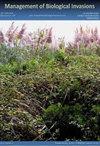Zero-altered modeling of an aquatic parasite host with application to invasive species risk assessments
IF 1.2
4区 环境科学与生态学
Q3 BIODIVERSITY CONSERVATION
引用次数: 2
Abstract
A fundamental consideration in aquatic invasive species risk management is the distribution of invasive taxa relative to the risk assessment area. However, sampling the distribution of aquatic invasive species (AIS) is costly and time consuming, especially when they are rare or clustered. While random sampling removes bias in most estimates, it could lead to many zeroes in the response variable if the target species is not evenly distributed. We surveyed the distribution of Tubifex tubifex , the obligate secondary host of Myxobolus cerebralis , an invasive parasite that causes whirling disease in salmonids. We used intensive grid and random sampling in a lake and two river systems but collected many samples with zero T. tubifex . Zero-altered models identified a single source of zero T. tubifex counts in each dataset and improved model validation compared to Poisson or negative binomial models. While T. tubifex counts were not predictable using the covariates we measured, the binomial processes identified zero odds of a T. tubifex occurrence at lake sites with water depths > 2 m and stream sites with channel slopes > 3%. These covariates could be used to stratify the landscape for future sampling, which would save survey time and resources and likely reduce uncertainty in parameter estimates. Model-based sample stratification could address some of the challenges with AIS surveys when species are at low abundance or are clustered.水生寄生虫宿主零改变模型及其在入侵物种风险评估中的应用
水生入侵物种风险管理的一个基本考虑是相对于风险评估区的入侵类群分布。然而,对水生入侵物种(AIS)的分布进行采样是昂贵和耗时的,特别是当它们是罕见的或聚集的时候。虽然随机抽样在大多数估计中消除了偏差,但如果目标物种分布不均匀,它可能导致响应变量中的许多零。我们调查了Tubifex Tubifex的分布,它是脑粘虫(Myxobolus cerebralis)的专性次级宿主,一种引起鲑鱼旋转病的入侵寄生虫。我们在一个湖泊和两个河流系统中使用了密集的网格和随机抽样,但收集到的许多样本中没有结核分枝杆菌。与泊松模型或负二项模型相比,零改变模型确定了每个数据集中输卵管输卵管输卵管计数为零的单一来源,并改进了模型验证。虽然利用我们测量的协变量无法预测管形舌虫的数量,但二项过程发现,在水深为bb10 ~ 2m的湖泊地点和河道坡度为bb10 ~ 3%的河流地点,管形舌虫的发生几率为零。这些协变量可以用来为未来的采样对景观进行分层,这将节省调查时间和资源,并可能减少参数估计的不确定性。当物种处于低丰度或聚集时,基于模型的样本分层可以解决AIS调查的一些挑战。
本文章由计算机程序翻译,如有差异,请以英文原文为准。
求助全文
约1分钟内获得全文
求助全文
来源期刊

Management of Biological Invasions
Agricultural and Biological Sciences-Ecology, Evolution, Behavior and Systematics
CiteScore
3.40
自引率
6.70%
发文量
21
审稿时长
16 weeks
期刊介绍:
Management of Biological Invasions, established in 2010 by Dr. Elias Dana, is an open access, peer-reviewed international journal focusing on applied research in biological invasions in aquatic and terrestrial ecosystems from around the world. This journal is devoted to bridging the gap between scientific research and the use of science in decision-making, regulation and management in the area of invasive species introduction and biodiversity conservation.
Managing biological invasions is a crisis science, with Management of Biological Invasions aiming to provide insights to the issues, to document new forms of detection, measurements and analysis, and to document tangible solutions to this problem.
In addition to original research on applied issues, Management of Biological Invasions publishes technical reports on new management technologies of invasive species and also the proceedings of relevant international meetings. As a platform to encourage informed discussion on matters of national and international importance, we publish viewpoint papers that highlight emerging issues, showcase initiatives, and present opinions of leading researchers.
 求助内容:
求助内容: 应助结果提醒方式:
应助结果提醒方式:


